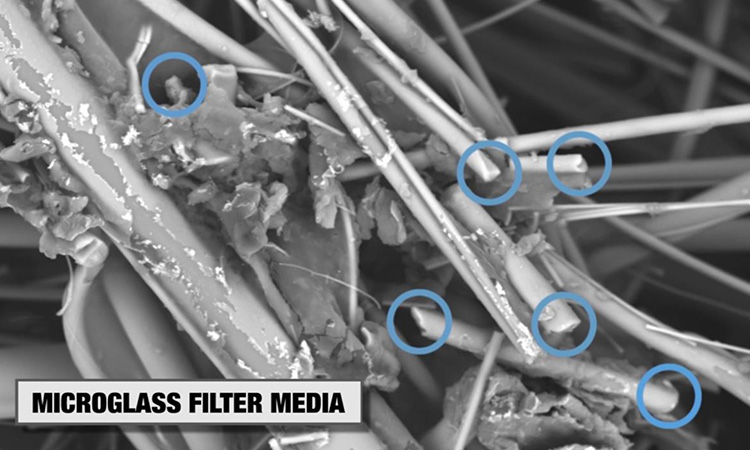Micro glass media and mesh media are two different types of materials used in the filtering process, each with its own unique characteristics and advantages. Let’s explore the differences between them:
1. Material Composition:
• Micro Glass Media: As the name suggests, micro glass media is made from fine glass fibers. These fibers are tightly woven or compressed to form a dense filtration material. The glass fibers offer high filtration efficiency due to their small size and uniform structure.
• Mesh Media: Mesh media, on the other hand, is typically made from metal or synthetic materials and consists of a woven or knit pattern with evenly spaced openings. The size of the openings determines the filtration level, and they are usually specified in microns.
2. Filtration Efficiency:
• Micro Glass Media: Due to its fine fibers and dense structure, micro glass media provides high filtration efficiency, capable of capturing particles down to submicron levels. This makes it suitable for applications where fine filtration is required, such as in cleanrooms, pharmaceutical processes, and high-purity water filtration.
• Mesh Media: The filtration efficiency of mesh media depends on the size of the openings or pores. While it can be effective in removing larger particles, it may not be as efficient as micro glass media when it comes to capturing fine particles.
3. Filtration Applications:
• Micro Glass Media: It is commonly used in applications requiring critical filtration, where even tiny contaminants need to be removed from the fluid or gas being filtered. Some typical applications include air and gas filtration in industries like aerospace, electronics, and healthcare.
• Mesh Media: Mesh media is often used in less demanding filtration tasks where relatively larger particles need to be filtered out. It is commonly found in applications like oil filters, hydraulic filters, and automotive air filters.
4. Pressure Drop:
• Micro Glass Media: Due to its dense structure, micro glass media may lead to a higher pressure drop across the filter. This means it may require more energy to push fluids or gases through the filter.
• Mesh Media: Mesh media typically results in a lower pressure drop because of its open structure with larger spaces between fibers.
5. Durability and Lifespan:
• Micro Glass Media: Micro glass media is generally more fragile and may have a shorter lifespan compared to mesh media.
Mesh Media: Mesh media tends to be more durable and can withstand higher operating pressures, making it suitable for use in rugged environments and heavy-duty applications.
In summary, micro glass media is preferred for applications requiring high filtration efficiency and fine particle removal, while mesh media is suitable for less critical filtration tasks involving larger particles and where a lower pressure drop is desired. The choice between these two media types depends on the specific requirements of the filtration process and the nature of the contaminants to be removed.
• Efficiency: Micro glass media is more efficient than mesh media at capturing contaminants. Micro glass media can remove particles as small as 0.1 microns, while mesh media can only remove particles as small as 10 microns.
• Dirt holding capacity: Micro glass media has a higher dirt holding capacity than mesh media. This means that micro glass media can filter more contaminants before it needs to be replaced.
• Lifespan: Micro glass media has a longer lifespan than mesh media. This is because micro glass media is less likely to clog than mesh media.
• Cost: Micro glass media is more expensive than mesh media.
• Reusability: Micro glass media is not reusable, while mesh media can be reused.
In general, micro glass media is a better choice for applications where high efficiency and long lifespan are required. Mesh media is a better choice for applications where cost is a major factor. Here is a table that summarizes the key differences between micro glass media and mesh media:

STAINLESS STEEL MESH MEDIA

Understanding Filter Efficiency and Beta Ratios
Filter testing and filter ratings are an often misunderstood area of contamination control. On several recent occasions, I have witnessed someone describing a filter by its nominal rating. A nominal rating is an arbitrary micrometer value given to the filter by the manufacturer.
These ratings have little to no value. Tests have shown that particles as large as 200 microns will pass through a nominally rated 10-micron filter. If someone tries to sell you a filter based on an “excellent” nominal rating of five microns, run away. Be sure that your fitler supplier provides clear information about filtration products that includes a beta rating, but more on that in a moment.
Absolute Rating
Another common rating for filters is the absolute rating. An absolute rating gives the size of the largest particle that will pass through the filter or screen. Essentially, this is the size of the largest opening in the filter although no standardized test method to determine its value exists. Still, absolute ratings are better for representing the effectiveness of a filter over nominal ratings.

Beta Rating
The best and most commonly used rating in industry is the beta rating. The beta rating comes from the Multipass Method for Evaluating Filtration Performance of a Fine Filter Element (ISO 16889:1999).

Table 1. Beta Ratios and Their Efficiency Percentage

Table 2. Effect of Filtration Ratio (Beta Ratio) on Downstream Fluid Cleanliness
To test a filter, particle counters accurately measure the size and quantity of upstream particles per known volume of fluid, as well as the size and quantity of particles downstream of the filter.
The ratio is defined as the particle count upstream divided by the particle count downstream at the rated particle size. Using the beta ratio, a five-micron filter with a beta 10 rating, will have on average 10 particles larger than five microns upstream of the filter for every one particle five microns or greater downstream.
The efficiency of the filter can be calculated directly from the beta ratio because the percent capture efficiency is ((beta-1)/beta) x 100. A filter with a beta of 10 at five microns is thus said to be 90 percent efficient at removing particles five microns and larger.
Caution must be exercised when using beta ratios to compare filters because they do not take into account actual operating conditions such as flow surges and changes in temperature.
A filter’s beta ratio also does not give any indication of its dirt-holding capacity, the total amount of contaminant that can be trapped by the filter throughout its life, nor does it account for its stability or performance over time.
Nevertheless, beta ratios are an effective way of gauging the expected performance of a filter.
I hope this new knowledge of filter efficiency ratings enables you to make a more informed purchase the next time you buy a filter.


